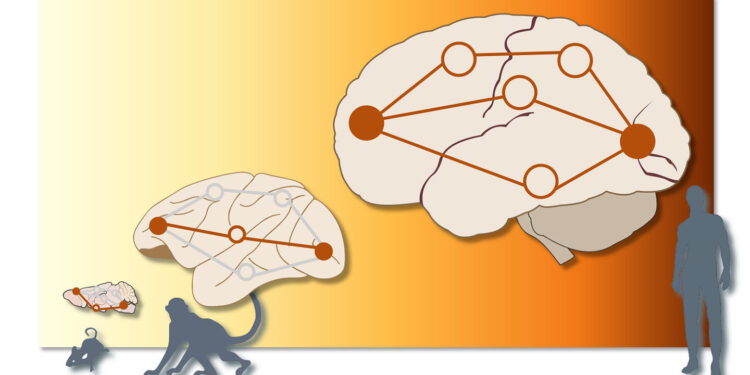In the brains of mice and macaques, information was sent along a single “route,” while in humans there were multiple parallel paths from the same source to the same target. Credit: Alessandra Griffa CHUV/EPFL CC BY-SA
In a study comparing the communication networks of the human brain with those of macaques and mice, EPFL researchers discovered that only the human brain transmits information via multiple parallel pathways, thus opening new perspectives on evolution of mammals.
To describe brain communication networks, Alessandra Griffa, senior postdoctoral researcher at EPFL, likes to use travel metaphors. Brain signals are sent from a source to a target, establishing a polysynaptic pathway that crosses multiple regions of the brain “like a road with many stops along the way.”
She explains that structural pathways of brain connectivity have already been observed based on networks (“routes”) of neuronal fibers. But as a scientist at the Medical Image Processing Laboratory (MIP:Lab) at EPFL’s Faculty of Engineering and a research coordinator at CHUV’s Leenaards Memory Center, Griffa wanted to follow patterns of information transmission to see how messages are sent and received.
In a study recently published in Natural communicationsshe worked with Dimitri Van de Ville, director of MIP:Lab, and Enrico Amico, member of FNS Ambizione, to create “brain traffic maps” that could be compared between humans and other mammals.
To achieve this, the researchers used open source diffusion (DWI) and functional magnetic resonance imaging (fMRI) data from humans, macaques and mice, collected while the subjects were awake and resting. DWI scans allowed scientists to reconstruct the brain’s “road maps,” and fMRI scans allowed them to see different regions of the brain light up along each “road,” which indicated that these pathways relayed neural information.
They analyzed the multimodal MRI data using information theory and graphs, and Griffa says it was this new combination of methods that yielded new insights.
“The novelty of our study is the use of multimodal data in a unique model combining two branches of mathematics: graph theory, which describes polysynaptic “roadmaps”; and information theory, which maps transmission of information (or “traffic”) via the roads. … The basic principle is that messages transmitted from a source to a target remain unchanged or further degrade at each stop on the road, like the telephone game played by We played when we were kids.”
The researchers’ approach revealed that in non-human brains, information was sent along a single “route,” whereas in humans, there were multiple parallel paths between the same source and the same target. Additionally, these parallel pathways were as unique as fingerprints and could be used to identify individuals.
“Such parallel processing in the human brain has been hypothesized, but has never been observed before at the whole-brain level,” summarizes Griffa.
Potential insights for evolution and medicine
Griffa says the beauty of the researchers’ model lies in its simplicity and in its inspiration of new perspectives and avenues of research in evolution and computational neuroscience. For example, the findings may be related to the expansion of human brain volume over time, which gave rise to more complex connectivity patterns.
“We could hypothesize that these parallel information flows enable multiple representations of reality and the ability to perform abstract functions specific to humans.”
She adds that even if this hypothesis is only speculative, as Natural communications The study did not involve any testing of the subjects’ computing or cognitive abilities, these are questions she would like to explore in the future.
“We studied how information flows, so an interesting next step would be to model more complex processes to study how information is combined and processed in the brain to create something new.”
As a researcher in memory and cognition, she is particularly interested in using the model developed in the study to determine whether parallel transmission of information could confer resilience to brain networks and potentially play a role in neurorehabilitation after brain injury or in the prevention of cognitive decline in pathologies. of advanced age.
“Some people age healthily, while others experience cognitive decline. So we would like to see if there is a relationship between this difference and the presence of parallel information flows and if they could be trained to compensate for the processes neurodegenerative.”
More information:
Alessandra Griffa et al, Evidence for increased parallel transmission of information in human brain networks compared to macaques and male mice, Natural communications (2023). DOI: 10.1038/s41467-023-43971-z
Provided by the Ecole Polytechnique Fédérale de Lausanne
Quote: More parallel “traffic” observed in the human brain than in animals (December 18, 2023) retrieved December 18, 2023 from
This document is subject to copyright. Apart from fair use for private study or research purposes, no part may be reproduced without written permission. The content is provided for information only.



